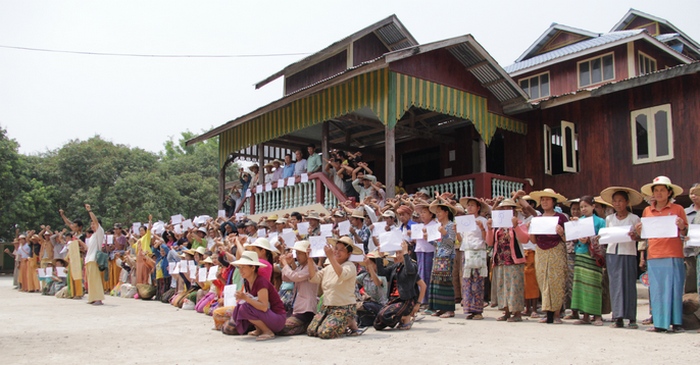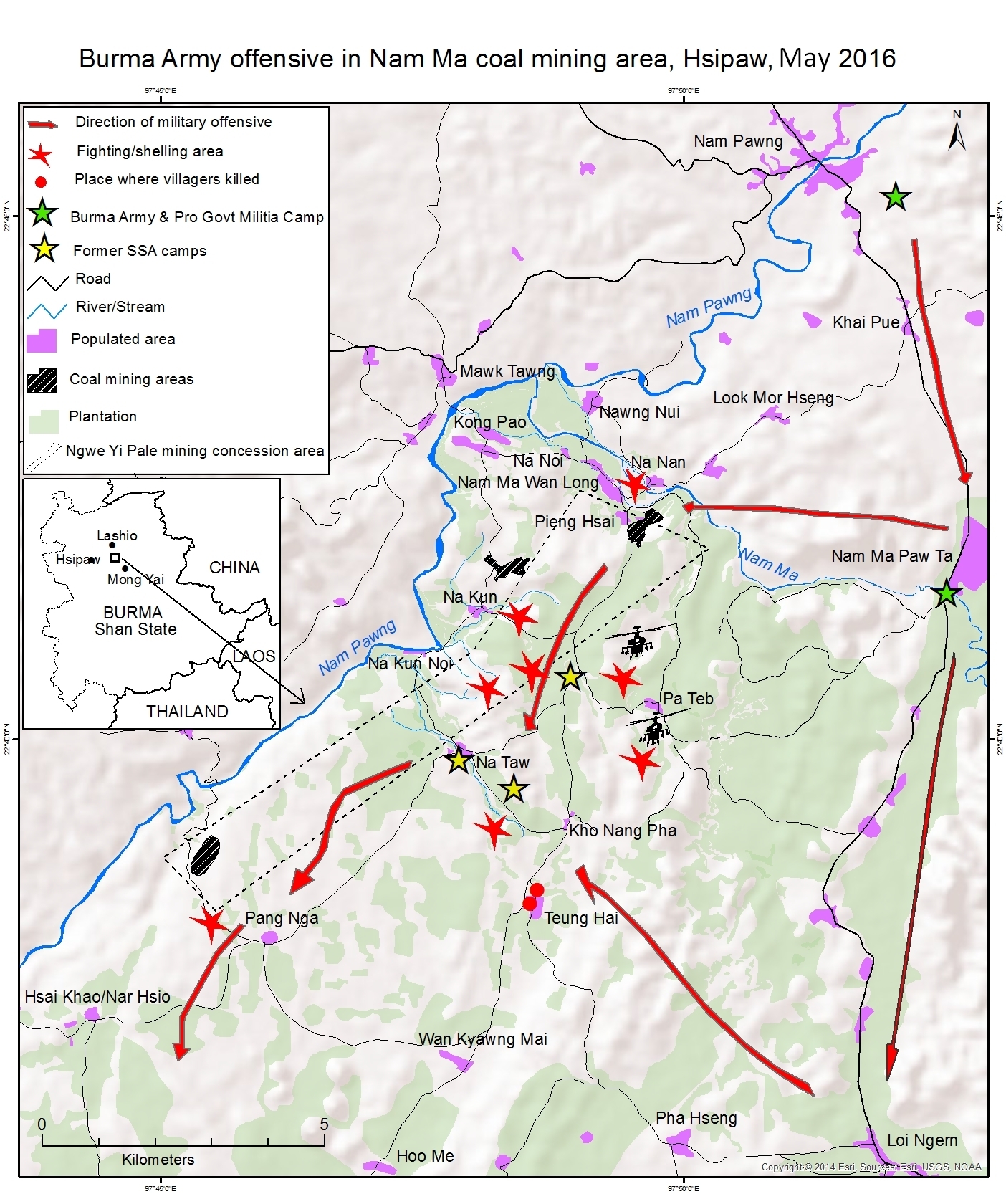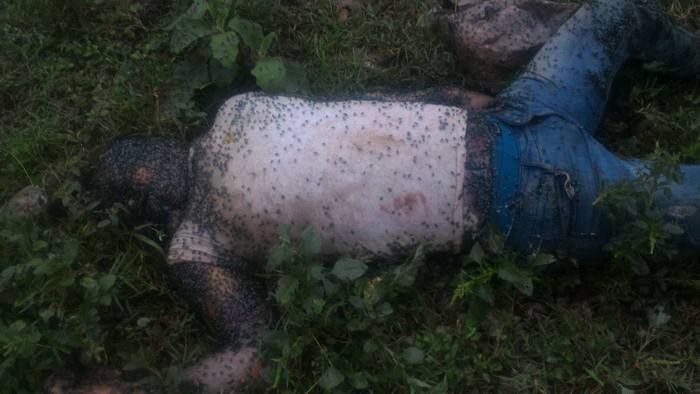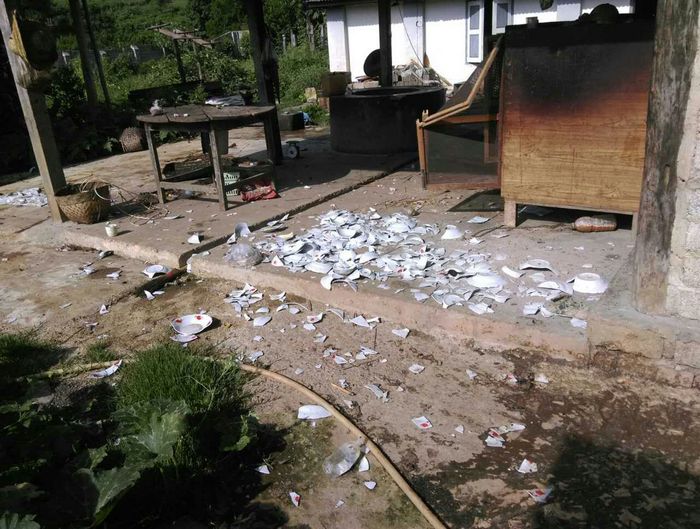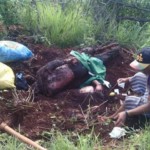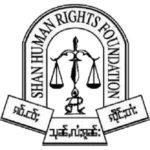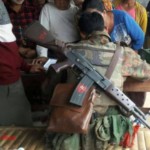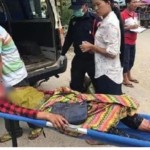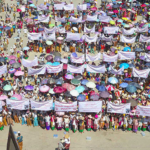Update by the Shan Human Rights Foundation (SHRF) | August 2, 2016
Burmese government troops committed serious human rights abuses, including arbitrary arrest, torture and killing of local villagers, during their offensive to drive out the Shan State Progress Party/Shan State Army (SSPP/SSA) from the coal mining area of Nam Ma, Hsipaw township, launched on May 18, 2016.
The large-scale offensive involved over 500 Burmese troops from four battalions — Lashio-based IB 41, Tangyan-based LIB 523, Mongyai-based IB 67 and Nam Pawng-based LIB 291 — as well as hundreds of pro-government militia troops (from the Man Pang militia and local Lahu militia), and helicopter gunships.
On May 18, Burma Army troops killed two civilians: a 34-year-old deaf-mute farmer was shot dead near his field, and a 25-year-old villager was shot on his motorcycle and then beaten to death with a rock. They also arbitrarily arrested and detained at least thirteen villagers, including a 16-year-old boy; some were beaten, tied up like animals, and forced to be porters. One of them, the 51-year-old headman of Wan Long, the main village in Nam Ma tract, has disappeared.
The attack, involving shelling and aerial bombing near civilian areas, caused over 1,000 villagers to flee their homes. Most fled to the towns of Hsipaw and Lashio. After they had fled, Burmese troops looted and destroyed most of the household property in the villages of Na Taw, Teung Hai and Kho Nang Pha. Villagers who did not flee were forbidden to farm their fields for three weeks. As this was the corn-planting time, it has seriously impacting their livelihoods.
Nam Ma is one of the main coal-producing areas in Burma. In the 1990s, the mines were operated directly by the Burmese military, but since 2004, the Mandalay-based Ngwe Yi Pale company, in a joint venture with Myanmar’s No. 3 Mining Enterprise, has become the main excavator. Villagers estimate that over a hundred large trucks transport lignite each day from the mines to Ngwe Yi Pale’s ‘’Crown” cement and sugar producing factories in Nawng Khio and Mandalay.
The mining has destroyed farmlands, blocked and contaminated water sources, and caused air pollution, particularly impacting Pieng Hsai and Wan Long villages. Despite repeated complaints from local communities, Ngwe Yi Pale company has continuously expanded its mining operations. On April 1, 2016, hundreds of villagers gathered at the Nam Ma temple, calling for the mining to stop.
On May 17, 2016, in response to villagers’ complaints about the mining, some SSPP/SSA officers arrived in a convoy of trucks from their Wan Hai headquarters (100 kms to the south) to survey the Nam Ma mining area, returning to Wan Hai in the evening. The very next day, on May 18, the Burma Army began their offensive, targeting the three SSPP/SSA camps south of Nam Ma, despite the SSPP/SSA’s existing ceasefire agreement with the government. The SSPP/SSA has now been forced out of the Nam Ma area, where it had been stationed for decades.
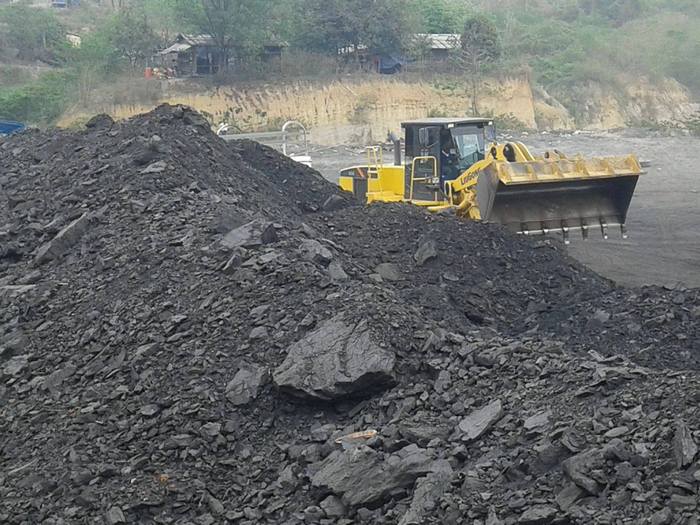
KILLING FOR COAL: arbitrary arrest, torture, and killing of villagers by Burma Army to secure Nam Ma coal mines in Hsipaw in May 2016
There is thus no doubt that a main aim of the offensive was to safeguard the mining operations. The Burma Army and their militia have now secured control of areas around the mines, including coal transport routes. Mining was suspended for about a week during the main fighting, but resumed on May 27, even while villagers around the mines were still forbidden by Burmese troops from going to their fields. During the offensive, a mining company truck was seen helping government troops transport goods looted from local villagers.
The Burma Army’s offensive in Nam Ma provides strong evidence that resource extraction projects in Burma’s war zones fuel conflict and inflict fresh abuses and displacement on local communities.
SHRF strongly condemns this offensive and the abuses committed against civilians. We reiterate our calls for the Burma Army to immediately end their offensives, troop expansion and abuses in the ethnic areas, and for an end to Burma Army impunity.
We also reiterate our calls to the Burmese government for an immediate suspension of all resource extraction projects in ethnic conflict areas. Projects should only be reconsidered when a federal peace settlement has been reached, granting local communities the right to decide over natural resources in their areas.
Details of human rights abuses by Burma Army troops
Note: Where necessary, pseudonyms (in inverted commas) have been used for the security of local villagers.
Deaf-mute villager shot dead at his farm
At about 9 am on May 18, a 34-year-old villager called Sai Sarm Tun was shot dead by Burmese troops at his farm near Tueng Hai village. Another villager, Sai Mwe, who was in a nearby field, saw a group of Burmese troops calling out to Sai Sarm Tun, and when he didn’t answer them, they shot him dead. Sai Mwe saw his body fall to the ground near the road beside his field, and he was so scared that he ran to hide from the troops. When he dared come out from hiding, he went to look for Sai Sarm Tun’s body, but it was no longer there. Until now, no one knows where the body has gone.
Motorcyclist shot, then beaten to death
At about 11 am on May 18, a 25-year-old villager called Sai Saw Ling from Wan Ho Tui village was riding a motorcycle through Teung Hai village when he was shot by Burmese soldiers in the village. He fell from his motorcycle in front of Sai Sui Nang Li’s house, at the end of the village, and then a soldier was seen picking up a rock and using it to batter his head many times, killing him. A soldier was also seen robbing money off his body. According to Sai Saw Ling’s relatives, he had been carrying 600,000 kyat (approx. USD 500).
The witness to this killing was an elderly villager, “Loong Kaw,” from Teung Hai. Almost all of the other villagers had already fled, but “Loong Kaw” had not managed to flee before about 50 Burmese soldiers arrived in Teung Hai in the morning of May 18. He was arrested, beaten and tied up by the troops under the house of Loong Swe Kham. He saw Sai Saw Ling being shot on his motorcycle, and then beaten to death in the road. Soon after this, “Loong Kaw” was released, and left Teung Hai on foot, to take refuge in the village of Mak Khaw Kyaung Kham.
Sai Saw Ling’s body was left in the road for several days, as no villagers dared clear it away. On May 21, some people from Hsipaw, including an SNLD MP, driving through Teung Hai village to pick up some refugees from Nam Ma, saw his badly decomposed body still lying in the road.
Finally, on May 22, the Teung Hai headman Loong Aye arranged for some villagers from Hoo Me to come and move the body and bury it outside Teung Hai village.
Disappearance of headman arrested by Burmese troops
On May 18, 2016, Loong Aw Aung, the 51-year-old headman of Wan Long Nam Ma, was returning from tending his farm at 7 am when he met a group of Burmese soldiers at Ho Loi Pieng Hsai. They searched him, found a walkie-talkie on him, and accused him of giving information to Shan soldiers. Two other villagers also detained on the same day, saw him in the custody of Burmese soldiers, and saw him being taken south by the troops in the direction of Na Taw. He has disappeared until today.
Farmer arbitrarily detained for seven weeks, used as human shield
Sai Hlu, a 25-year-old farmer from Pieng Hsai village, was in his field at about 3 pm on May 18, when a group of Burmese soldiers found him. He was accused of being a Shan soldier, and handed over to troops of LIB 291, who took him with them during their operations in the area, sometimes making him walk in front of them as a human shield. On May 22, he was sent to the Nam Pawng army base (north of Nam Ma), and only released on July 7, 2016, after many appeals from local community leaders and an SNLD MP from Hsipaw.
– Farmer severely beaten, causing permanent eye injury
On May 18, “Sai Kaw,” aged 30, from Wan Long, was arrested by Burmese soldiers on his farm. He was tied up, taken with the troops, and slept in the jungle with them for one night. He was not given anything to eat. The next evening he was released, and slept in a farm hut, then tried to return home. However, he met another group of Burmese soldiers near Pieng Hsai. About 4-5 soldiers forced him to the ground, and began beating him with fence sticks. They beat him on his legs, his body and his head, causing blood to come out from his ears and his right eye. They questioned him about where he was from, and when he said he was a village from Wan Long, they released him, saying they had beaten the wrong person. They put him on a car passing by, which then took him back to his house. He had to receive medical treatment for his injuries, and his eyesight is now permanently damaged.
Two villagers arrested and tied up for five days
On May 19, “Sai Boon,” aged 42, from Na Nan village, had gone to Parng Na village to distribute invitations to a religious ceremony. He had slept at the headman’s house, and the next morning, at 6 am, he was walking around the village, when hundreds of Burmese soldiers suddenly entered the village. When they found him, they asked him where all the villagers had gone. When he said they had run away, they asked him why he had also not fled. He told them he was just a local villager, but the Burmese troops made him lie on the ground, and tied his hands behind his back. They then took him with them in the battlefield for 4 nights and 5 days, to Hsai Khao, Pang Nga, Kawng Mark Moang, and Na Nio Lak Tang villages. When the troops were in the jungle, he was tied under trees. When the troops stayed in villages, they tied him up under villagers’ houses. On May 25, when they arrived at Mark Khaw Kyaung Kham village temple, an abbot from Nawng Nguen temple came to the temple on that day, and requested the Burmese soldiers to release the villagers they had detained, but only Sai Boon was released.
On May 19, “Sai Lao,” aged 40, from Wan Loi Ngeun (in Mong Yai), was at his mother’s farm in Teung Hai, when a group of Burmese soldiers came and arrested him. They took him to Parng Nga, tied up his hands and took him with them on their operations around the area until May 25, together with “Sai Boon” (described above). “Sai Lao” was not released with Sai Boon at Mark Khaw Kyaung Kham, but shortly afterwards was taken to Na Taw, and was able to run away from the Burmese troops there.
Four farmers tied up, forced to be porters
Four farmers from three villages in Nam Ma tract were forced to carry rice for Burmese soldiers during clashes with the Shan troops. They were detained for periods of up to two weeks. Details are as follows:
- On May 18, “Sai Sai”, aged 21, from Wan Long village, had just dropped off a worker by motorbike at his farm, at around 7 am, when he was stopped by about 70 Burmese troops near Pieng Hsai. They interrogated him about the whereabouts of the Shan bases in the area, and also about cooperation between Ta’ang and Shan soldiers. While they were interrogating him, two trucks were seen driving along the road about a mile away. The Burmese soldiers began shooting at the trucks, and threw a grenade at them. The front wheel and front door of one of the trucks were hit. At that time, two men rode a motorbike along the road. The Burmese soldiers also shot at them, but did not hit them.
After they had interrogated Sai Sai, the Burmese soldiers tied up his hands and forced him to carry a sack of rice for them into the jungle towards Na Taw. He was released at around midday. At that time, Burmese military helicopters were dropping bombs in the area.
- In the morning of May 18, “Sai Hla”, aged 30, from Wan Long village, was riding his motorbike on his way to see his wife who was sick, when he was stopped by a group of Burmese soldiers. He was tied up and forced to carry rice for the soldiers, together with Sai Sai (above). After midday, he was released.
- On May 19, “Sai Mooling,” aged 20, was returning home to Na Koon village from his fields at about 4 pm, when he met a group of about 50 Burmese soldiers. He was accused of being a Shan soldier, and interrogated about the Shan troops. He was tied up and taken with the Burmese soldiers to Na Taw for seven days and seven nights. After that, they took him to the jungle near Parng Nga, where he was tied under a tree for one night. Then he was forced to carry rice for the troops to the village of Mark Khaw Kyaung Kham, where he was tied under a villager’s house for six days and six nights. He was released on June 2.
- On May 19, “Sai Ti”, aged 40, from Nawng Nwe village, was arrested by a group of Burmese soldiers at Na Koon, slapped, tied up and taken to Parng Nga. He was then forced to carry rice for Burmese troops around the Na Taw area. He was released on June 2.
Farmer arbitrarily detained for childhood scar, kicked, forced to porter
“Sai Su”, a 40-year-old farmer from Na Taw village, had a scar on his wrist from an injury when he was seven years old, when his arm was caught in a sugar cane crusher. He had fled from his village on May 18 with other villagers, to take refuge in Kyaung Bo Daw monastery. On May 22, in the morning, he was returning with another villager to check on his home, when they met a group of Burmese troops at Parng Nga. The soldiers questioned the two men, then detained them at Parng Nga for one night, together with another eight villagers, who had already been detained. The next day, the soldiers released all the villagers, except for Sai Su, because they had found the scar on his wrist, and accused him of being of a Shan soldier because of the scar. They questioned him again and again in Burmese, asking him where he kept his gun, and threatening to kill him with a knife. However, he could not properly understand Burmese. They forced him to kneel on the ground, with his hands tied behind him, and kicked him in the head so that he fell to the ground. They kept him for one night, then forced him to carry their supplies to Mark Kaw village. When they reached there, they tied him up under a house until June 2nd, when he was finally released.
16-year-old boy and 55-year old village leader beaten and tied up after finding SSPP magazine
On May 27, a group of Burma Army troops and militia patrolling around Pieng Hsai village entered the house of Nai Inn Oon, and found her grandson, 16-year-old Sai Ba there. When they saw a magazine published by the SSPP/SSA in the house, they questioned Sai Ba about where he had got the magazine, then beat him, tied him up, and took him to another house and called one of the village leaders called Bu Murng to question him about the magazine. The soldiers slapped Bu Murng and kicked him in the chest. Both he and Sai Ba were tied up under the house for the night. The next morning, some other village elders and a monk came to plead for the villagers to be released. They explained that the magazines had been distributed by the SSPP/SSA when they had attended a ceremony a few years earlier. The Burmese troops then released the two detained villagers, but told the villagers that they should not read such magazines.
Shelling near civilian areas
On May 20, 2016, at around 11 am, Burmese troops fired 60 mm mortars in two locations north of Pieng Hsai village. They fired three shells towards some villagers who were in their farm, but fortunately none of them was hit. They also fired a shell towards Nam Ma monastery, which landed only 300 feet from the monastery, which housed 156 novices and monks. Soon afterwards, the abbot and all the novices fled to seek refuge in Hsipaw.
Villagers’ property destroyed and looted by Burma Army – with the help of mining company
After most villagers had fled from Na Taw, Teung Hai and Kho Nang Pha villages, Burmese troops looted and destroyed property in all the houses in these villages. Edible food stuff and valuables were mostly looted, while sacks of crops were slashed open and scattered. Motorcycles were either smashed up or burned.
On May 21, local villagers saw a truck belonging to Ngwe Yi Pale company carrying goods looted from Na Taw village (including solar panels) to the village of Na Nan in Nam Ma tract. The goods were unloaded there, and then picked up by a truck belonging to the Man Pang government militia.
During the offensive, the Burmese troops camped in local people’s houses in Na Ma tract. They took whatever food they wanted from the houses. A villager from Pieng Hsai described this: “There were about 100 soldiers camped in our village. 22 soldiers slept in my house for three nights. They took our rice, salt and oil to cook for themselves. Fortunately there were no young women in the village. They had all fled when the fighting started.”
Details of property looted or destroyed in Na Taw village
| No. | Owner | Village | Property either looted or destroyed | Approx. value |
| 1. | Sai Harn + Nang Harn | Na Taw | 6 sacks of rice, 1 motorbike, 7 sacks of corn crops, 4 sacks of soybean crops, 2 solar cells and 1 battery | 1,200,000 kyat =1,016 USD |
| 2. | Sai Hsarng Noom + Nang Aye Khur | Na Taw | 1 motorbike, 7 sacks of rice, solar cell and battery | 1,000,000 kyat = 847 USD |
| 3. | Sai Pandi | Na Taw | 2 sacks of rice, wardrobe, clothes and 1 motorbike | 1,100,000 kyat = 932 USD |
| 4. | Pa Nyo | Na Taw | 1 Buddha image, 5 sacks of rice, solar cell, battery and clothes | 3,500,000 kyat =2,966 USD |
| 5. | Loong Tun Aung + Pa Nang Pao | Na Taw | 1 motorbike, 8 sacks of rice, 1 solar cell and 2 batteries | Over 1,000,000 kyat =847 USD |
| 6. | Loong Pan + Pa Hla Khin | Na Taw | 1 motorbike, 6 sacks of rice, 2 batteries and clothes | Over 1,000,000 kyat =847 USD |
| 7. | Loong Maung Aye + Nang Aw Pin | Na Taw | 1 motorbike, 6 sacks of rice, solar cell, battery and all household possessions damaged | Over 1,000,000 kyat =847 USD |
| 8. | Loong Kaw Kham + Pa Ngeun Lu | Na Taw | 1 motorbike, 7 sacks of rice, all household possessions damaged | Over 900,000 = 762 USD |
| 9. | Loong Hsaw Har + Pa Oo | Na Taw | 4 sacks of rice, chicken and all home possessions damaged | 800,000 kyat =677 USD |
| 10 | U Na + Pa Pao | Na Taw | Earrings, necklace, 5 sacks of corn crops, 3 sacks fertilizer, 1 can of diesel, 1 can of petroleum, 5 sacks of rice, saw machine and all household possessions damaged | Over 1,200,000 kyat =1,016 USD |
| 11. | Sai Hsarng Leng + Nang Aye Zing | Na Taw | 6 sacks of rice and all household possessions damaged | Over 800,000 kyat =677 USD |
| 12. | Loong Kyaw Aom + Pa Nang Shwe | Na Taw | 1 Buddha image statue, 1 ploughing machine, 3 cans of diesel, cooking oil | 21,000,000 kyat=1779 USD |
| 13. | Loong Kaling | Na Taw | 3 sacks of rice, the entire roof, and all household property damaged | N/A |
| 14. | Pu Aung | Na Taw | 33 sacks of corn crops, machine, 11 sacks of rice, 1 motorbike and all household property damaged | 1,050,000 kyat =889 USD |
| 15. | Loong Pan Hsar | Na Taw | 8 sacks of rice, earrings worth 650,000 kyat (=550.83 USD), 1 motorbike, 6 sacks of corn crops, 7 sacks of white sesame, 1 sack of Japanese sesame | 1,661,000 kyat =1407 USD |
| 16. | Pu Korm | Na Taw | 4 sacks of rice, and all household property damaged | 460,000 kyat=389 USD |
| 17. | Pu Kyaw + Nai Noom | Na Taw | 11 sacks of rice, 18 sacks of rice reserved for donation, 27 sacks of paddy and all household property damaged | Over 1,000,000 kyat =847 USD |
| 18. | Sai Aung Pan + Nang Twe | Na Taw | 1 motorbike, 3 sacks of rice and all household property damaged | 700,000 kyat =593 USD |
| 19. | Sai Hsarng Maung + Nang Keang | Na Taw | 21 sacks of corn crops, 1 sack of fertilizer, 5 sacks of rice, 2 cows, battery, solar cell and all household property damaged | 1,450,000 kyat=1,228 USD |
| 20. | Loong Sai Maung + Pa Nang Koi | Na Taw | 5 sacks of rice, solar cell, battery and all household property damaged | 300,000 kyat =254 USD |
| 21. | Sai Shwe + Nang Aye Lu | Na Taw | All household property damaged | 375,000 kyat=317 USD |
| 22. | Loong Di Aom + Pa Phit | Na Taw | 5 sacks of rice and all household property damaged | 800,000 kyat =677 USD |
| 23. | Sai Hsarng Lu + Nang Yi | Na Taw | 1 hot water machine, 2 motorbikes, 3 sacks of rice, the entire roof, all household property damaged, and money (357,000 Ks)taken | 3,000,000 kyat =2,542 USD |
| 24. | Sai Hsarng Lu + Nang Aye Pao | Na Taw | 10 sacks of rice, 1 can petrol, 2 cans diesel, 7 sacks of fertilizer, 2 sacks of corn crops, 1 bag of salt and 1 insecticide spraying machine | 2,500,000 kyat =2,118 USD |
Details of property looted or destroyed in Teung Hai village
| No. | Names of owners | Village | Property either looted or destroyed |
| 1. | Loong Phui + Pa Kya Kham | Teung Hai | 4 kgs of rice and an old musket |
| 2. | Loong Twe + Pa Tio | Teung Hai | 2 sacks of rice |
| 3. | Pa Koi | Teung Hai | 1 ring and necklace worth 300,000 kyat (254.23 USD) |
| 4. | Loong Shwe Kham + Pa Khem | Teung Hai | 1 tin of cooking oil |
| 5. | Loong Zaring + Pa Kya | Teung Hai | 2 kgs rice and half a sack of rice |
| 6. | Loong Aung (village tract chairman) | Teung Hai | 1 mobile phone, 47 credit refill cards and one television |
| 7. | Sai Pan Sein + Nang Tun | Teung Hai | 9 litres of cooking oil, 2 chickens |
| 8. | Loong Pang + Pa Nyunt | Teung Hai | 4 kg of rice |
| 9. | Sai Oong + Nang Lu | Teung Hai | 1 sack of rice |
| 10. | Hsarng Phit + Nang La | Teung Hai | 10 kgs of rice |
| 11. | Hsarng Mart + Nang Mwe | Teung Hai | 1 knife |
| 12. | Sai Lord + Nang Soi | Teung Hai | 1 television |
| 13. | Loong Luen + Nang Yawn | Teung Hai | 1 television |
| 14. | Loong Jina + Pa Khaung | Teung Hai | 1 television and CD player |
| 15. | Loong Nemin + Pa Lu | Teung Hai | 1 solar cell, clothes and 1 big cooking oven |
| 16. | Loong Kham Leng | Teung Hai | 1 television |
| 17. | Sai Wala + Nang Hsang | Teung Hai | 2 bags of corn crops |
| 18. | Loong Nyar + Pa Naw | Teung Hai | Blankets, bed-sheets, and all household possessions |
| 19. | Loong Aye + Pa Mu | Teung Hai | 1 sack of rice, 1 TV, 1 cooking oven and all household possessions |
| 20. | Loong Nyar Na + Pa Naw | Teung Hai | Blankets, and all household possessions |
| 21. | Ai Hsarng Pe + Nang Ing | Teung Hai | 2 sacks of rice, goods worth 800,000 kyat (677.95 USD) |
| 22. | Pa Kya | Teung Hai | Rice |
| 23. | Loong Kyaw + Pa Pee | Teung Hai | 2 sacks of rice and a big cooking oven |
| 24. | Sai Kaw Ya + Nang Shwe | Teung Hai | All household possessions taken |
Contact
Sai Hor Hseng +66: (0) 62- 941-9600 (English, Shan)
Sai Kheun Mai +66: (0) 94-638-6759 (English, Burmese)

